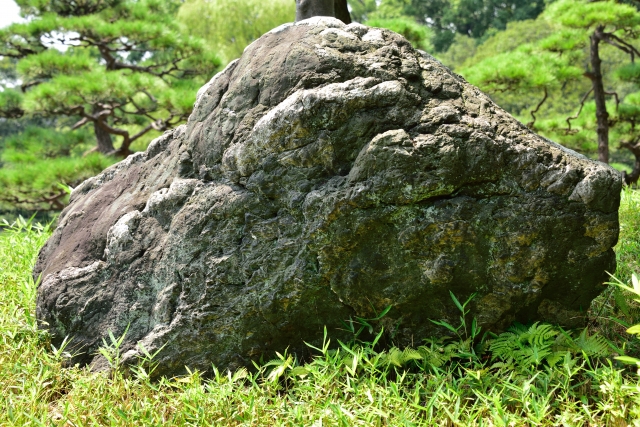Natural stones do not become stone gardens as they are. A fine stone garden appears only when a gardener adds his or her own touches and combines the stones into an ideal shape. This is where the conception, artifice, and techniques of landscaping technology are needed.
Then, what kind of mindset and attitude do gardeners have when assembling the stones? The late Mr. Keiji Uehara, the founder of landscape gardening education in Japan, explained his state of mind in assembling stones, so let’s take a look at what he has to say.
Reference: Keiji Uehara, How to Create a Stone Garden, Kajima Shoten, 1996.
state of mind to assemble stones
The arrangement of stones is a way of arranging garden materials in a beautiful way to enhance the beauty of the garden in the mind of the observer. In this sense, it is no different in spirit from planting garden trees as well as stones.
However, garden trees have a life of their own and cannot be left unattended after planting. Therefore, they must be planted so that they can be easily seen at a glance and maintained, which is easier to do than with stones.
Animals have instincts, and plants have nerves, and their functions as landscaping materials are utilized when they are skillfully captured and utilized. This is the mindset of a gardener who works with garden plants.
What does a stone have in common with a garden tree? Stones have their own “momentum. However, the momentum of a stone does not appear figuratively on the outside, like instinct or nerves. However, because of this “momentum,” the stone is not mindless, and one can sense that the stone is alive. And it is the passion and drive of the stone garden artist that gives it even more life. This is precisely the gardener’s attitude toward the stone.

Sample of stone assembly
The best examples of masonry can be found in the river and seashore scenery scattered throughout Japan. Great natural laws can be seen in these places. Such natural scenery is the model for stone garden design.
However, the appreciation of the beauty of the landscape is superficial. However, this is a part of the natural landscape. It is what it is, constrained by the topography and subject to the pressure of water pressure. Therefore, aesthetically, it has many flaws. The idealized form of a stone garden is the essence of a stone garden.
In creating a stone garden, the construction of stones must be done with the formal principles of beauty in mind. It is the result of mental unification. All emotions must be concentrated according to the shape of the stone, and then, in the light of its movement and momentum, it must be made to move, and as a result, a complete figurative form will be achieved.

Preparation for masonry
Dr. Keiji Uehara presents 12 contents for the preparation of masonry.
- It is not advisable to be too hesitant in choosing stones.
- Look around the stones and memorize their shapes.
- Once you start assembling, finish it in a single stroke.
- The work done when you are full of energy will always be good.
- Of course, he does not do the work himself, but his spirit is reflected in the work of the gardener.
- Long thoughtful and considered work is not bad, but it is sometimes mediocre.
- A work done in a single breath may have faults in some peripheral parts, but the central part, the framework, is outstanding.
- Only the defective peripheral parts need to be corrected or reworked later.
- Start with the main stone, but even if there are some defects in the placement of the main stone, it is better to set it in a position that you intuitively believe is acceptable and not to make too many changes.
- There are many ways to supplement the main stone with the accessory stones. Sometimes, the shape of a stone that seems to be defective can be made the best use of by the addition of the accessory stones.
- In this respect, when the stone is brought in and unloaded from the car, it should be rearranged so that the main shape of the stone can be easily seen, although this may take a little time and effort. This rearrangement saves time and effort in setting up the stone in hindsight.
- the process should be carried out in such a way that the time required to set the stones in place decreases at an accelerated rate as the number of stones is reduced. In this way, it is a good idea not to hesitate too much, but to concentrate with high spirit and single-mindedly assemble the stones. This is a technique that cannot be done without gaining some experience and touching hundreds of stones.
A gardener is so focused when he is assembling stones that he forgets about time, sleep, and food. No matter how loud the chorus of cicadas may be, he concentrates as if he were in silence. This is what Ishigumi means when he says that this is the result of mental unification. It requires a high level of concentration to put the stones in order while simultaneously considering the partial optimum, which is to determine the momentum of each stone, and the overall optimum, which is the sum total of the momentum of all the stones assembled at the same time. This is where the skill of the gardener really shines.


